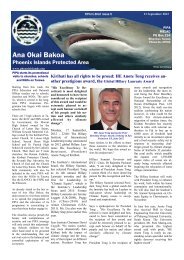Nomination for a World Heritage Site 2009 - Phoenix Islands ...
Nomination for a World Heritage Site 2009 - Phoenix Islands ...
Nomination for a World Heritage Site 2009 - Phoenix Islands ...
You also want an ePaper? Increase the reach of your titles
YUMPU automatically turns print PDFs into web optimized ePapers that Google loves.
Jamie Gove in Maragos et al (2008) provided a sketch of the equatorial current system in the<br />
central Pacific shown in the figure below. The <strong>Phoenix</strong> <strong>Islands</strong> were in an area of unique<br />
subsurface water currents. This may have great significance <strong>for</strong> dispersing larvae originating<br />
from the <strong>Phoenix</strong> <strong>Islands</strong>.<br />
Sketch of equatorial current system in the central Pacific Ocean (170 0 W) including the Equatorial Intermediate<br />
Current (EIC), the North and South Subsurface Countercurrents (NSCC and SECC). (Source: Maragos et al<br />
Coral Reefs of the USA, 2008). Cross-sectional sketch of the equatorial current system in the central Pacific<br />
Ocean (170° W). Shown in crosshatch are the North and South Equatorial Countercurrent (NECC and SECC),<br />
subsurface Equatorial Intermediate Current (EIC), North and South Subsurface Countercurrents (NSCC and<br />
SSCC), and Equatorial Undercurrent (EUC ). Eastward flow is colored green or brown, and all westward flow is<br />
white, including the North Equatorial Current (NEC) north of 5° N and the South Equatorial current (SEC )<br />
south of 5° N and outside the EIC. Black numbers in italics were observations from January 1984 to June 1986<br />
(latitude 165° E), and bold red numbers were observations from April 1979 to March 1980 (latitude 155° W),<br />
with both representing transports in Sverdrups (Sv = 106 m3/s) (Modified from Tomczak and Godfrey (2003).<br />
MARINE ECOSYSTEMS<br />
The marine environment of the PIPA is extremely diverse. It varies from the spectacular<br />
turquoise lagoons with huge coral heads and clams to pristine and colorful coral reefs that<br />
<strong>for</strong>m and surround the atoll, low reef islands and submerged reefs down the slopes of the<br />
massive volcanoes to the ocean floor to over 6,000 meters deep. The marine environment of<br />
the PIPA is known to support a number of globally endangered and endemic species and<br />
hosts interesting and unique species assemblages not found elsewhere in the world.<br />
From a marine science perspective the PIPA is extremely important because of the minimal<br />
human impacts and hence it’s near pristine state. In addition PIPA is biogeographically<br />
uniquely situated in the center of the equatorial Pacific. PIPA plays a significant role in<br />
movements and dispersal of marine animals and larvae. Little is still known about the full<br />
effect of these islands on the surrounding pelagic marine species and systems, which in turn<br />
support internationally important seabird populations and numerous migratory birds.<br />
Signs (prolific algae growth) of unusually high nutrient levels <strong>for</strong> oceanic atolls have been<br />
observed in the <strong>Phoenix</strong> <strong>Islands</strong>. This effect could be caused by a combination of lagoon<br />
enrichment, leaching of guano deposits or oceanic upwelling caused by deep currents striking<br />
the massive seamounts underlying each of the <strong>Phoenix</strong> <strong>Islands</strong>. Pierce et al (2006) suggested<br />
35





